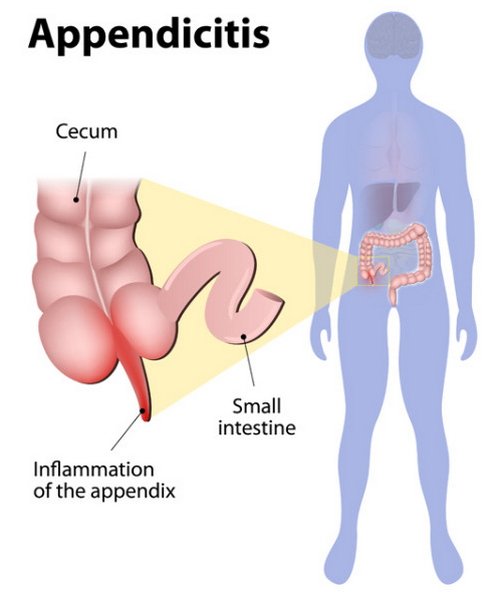Appendicitis is the inflammation of the appendix. What is an appendix? It is a tiny sac attached in the cecum (first section of the colon) in the right lower quadrant of the abdomen.
It is a vermiform appendix because of its resemblance to a worm. It is anatomically positioned in the right iliac region of the abdomen. (1, 2)

Image 1: The anatomical presentation of the appendix. It is an appendage, which resembles like a worm.
Photo Source: images.onhealth.com
Other names for appendix
- Vermiform appendix
- Cecal appendix
- Vermix
The functions of the appendix
- It contains lymphatic tissue, which plays a very important role in immune function.
- It functions as a storage area for good bacteria.
- It hastens the recovery from illness by allowing the good bacteria to re-colonize the intestines. (1, 2, 3)

Picture 2: The image shows the inflammation of the appendix or medically known as appendicitis.
Image Source: cdn.universityhealthnews.com

Photo 3: The progression of appendicitis throughout the course of time.
Picture Source: edition.channel5belize.com
Where is the appendix located?
What side of your body is your appendix? It lies at the junction of the small and large intestines. Ti is a finger-like pouch located in the right lower quadrant. It is four inches long and as thick as that of a pencil. (2, 4)

Picture 4 : Appendix location with Mcburney’s point
What side your appendix on? It is found on the right side of the body, on the right hand side of the abdomen, just above the waist. To find out the exact location of the appendix, you should do these steps:
Locating the appendix using the hip bone
- Palpate and place your thumb on the top part of your right hand hip bone.
- Place the pinky finger on the side of the pubic bone.
- Extend your index finger and there you will locate the exact position of the appendix.
Locating the appendix using the McBurney’s point
The location of the appendix is called the McBurney’s point. To locate the McBurney’s point, create an imaginary line from the navel to the right side of the hip bone. The location of the appendix is about 2/3 away from the navel.
The exact location of the appendix is helpful in accurately diagnosing appendicitis. The doctor applies pressure to the McBurney’s point to confirm if the abdominal pain is caused by an inflamed appendix. (1 4, 6)
What side does your appendix hurt on?
Pain in the abdomen is one of the clinical manifestations of appendicitis. However, there are other health conditions causing abdominal pain. Hence, it is important to know which side of the body is inflamed and in pain if you have appendicitis.
- Appendicitis related pain usually begins at the center of the belly.
- As the condition progresses, the entire abdominal wall is swollen and irritated leading to a localized pain at the right lower quadrant of the abdomen.
- A rebound tenderness is used to detect the location of the appendix pain. The doctor will gently press the abdominal area to watch out for signs of tenderness. Once the doctor releases the pressure, the pain in the abdominal area gets worst.
- The location of appendicitis pain can also be pinpointed when the patient takes a deep breath or simply coughs or sneezes. (2, 5, 8)
What causes appendicitis?
The exact cause of appendicitis is unknown. However, many health experts believed that it has something to do with the blockage in the entrance of the appendix. It could be a small piece of fecal matter or a foreign substance that blocks the appendix.
If the blockage is not removed, it will cause pressure to the appendix. The appendix will swell and will eventually burst. (2, 3, 4)
Clinical manifestations
- Pain in the abdomen that is quite difficult to pinpoint.
- The patient usually complains of pain the mid portion of the abdomen and radiates to the right lower abdominal quadrant.
- Loss of appetite
- Weight loss (5)
- Nausea and vomiting
- Fever
- Unable to pass gas
- Fatigue (4)
Prevalence rate
Nobody is spared from appendicitis. Anybody can be a target. However, it is most common in people aged 10 years old and 30 years old. Young children and older people are prone to appendicitis complications.
Therefore, it is important to detect the condition the earliest time possible to prevent complications. (4, 5, 6)
Appendicitis in children
Appendicitis in children have varying reasons. Children usually complains of stomachache but it could be associated with other conditions such as gas, constipation, and mild food allergy. An abdominal pain that spreads to the right lower quadrant of the abdomen is one of the cardinal signs of appendicitis.
Other symptoms affirmative of appendicitis in children include abdominal pain that gets worst with movement, coughing, sneezing, nausea, lack of appetite, and deep breathing/labored breathing. Very young children have distinct set of symptoms too such as abdominal pain, fever, loss of appetite, and vomiting (children 2 to 5 years old). (6, 7, 8, 9)

Image 5: One of the diagnostic procedures used to check the condition of the appendix.
Photo Source: www.acep.org
How to diagnose appendicitis?
To accurately diagnose appendicitis, the doctor will thoroughly examine the patient’s clinical manifestations. The doctor will check the abdomen to detect the exact location of pain. When the doctor pushes down the right lower quadrant of the abdomen, the patient usually complains of moderate to severe pain.
When the doctor removes the pressure on the abdomen, the pain intensifies. To check for the presence of infection, the doctor will order a blood test. An increase in white blood cells indicates that there is an ongoing infection. Additional procedures might be needed such as x-ray and CT scan of the pelvis and abdomen. (7, 8, 9, 10)
Treatment options for appendicitis
An inflamed appendix should be surgically removed. If it burst inside the body, it could cause serious complications. It would put the patient in a life-threatening situation. To remove the appendix, an appendectomy is performed.
It is performed under general anesthesia using the open technique or the keyhole method. (2, 4)
Antibiotics
The patient should receive antibiotics before and after the surgical removal of the appendix.
Photo 6: A keyhole surgery is one of the less invasive procedures for removing appendicitis.
Picture Source: www.misurgery.com.au
Image 7: Appendectomy using the open surgery method.
Photo Source: i.ytimg.com
Picture 8: A laparoscopic procedure in a patient with perforated appendicitis.
Image Source: dccdn.de/pictures.doccheck.com
Surgery
- Open surgery – It is the surgical technique used if the appendix has already burst. It is also the technique of choice for patient who has had an open abdominal surgery. As the name suggests, a single huge cut is made in the lower right quadrant of the abdomen.
- Laparotomy – A laparoscopic procedure is when a surgeon makes a cut along the middle of the abdomen. This is the surgical approach for patients with widespread peritonitis. It is a complication of appendicitis. It occurs when the tissues that line the abdomen (peritoneum) become inflamed.
- Keyhole surgery – It is the most ideal surgical approach for patients whose appendix hasn’t burst yet. A tiny cut in the belly button is made and a special instrument is inserted, which enables the surgeon to completely view the appendix and the surrounding structures. Using a small surgical tool, the appendix is removed. The incision site will be closed using dissolvable stitches. If the doctor used regular stitches, they should be removed after a week. (1, 6, 8, 10)
Recovery time
The recovery period depends on the patient’s overall health condition and the type of surgical approach used. The keyhole technique has a faster recover period than the open surgery and laparotomy. With keyhole surgery, the recovery time is short.
The patient can go home a few days post-surgery. There are instances when the patient can go home 1 to 2 days after surgery. However, if the patient has a complicated surgery such as in the case of peritonitis, the patient will most likely need to spend the entire week in the hospital post-surgery for thorough monitoring. (2, 3, 6, 7)
What to expect after the surgical procedure?
- Pain and bruising in the incision site.
- Pain in the tip of the shoulder that could last for a week (keyhole surgery).
- Short-term constipation (2, 3)
Post-surgical care
- You should take pain killer and anti-inflammatory as prescribed by your doctor.
- Avoid strenuous activities.
- Wound dressing is a must.
During the recovery period, there is a possibility that the patient will not be able to recover completely. There is always a possibility of post-surgical problems.
It is important to keep an eye for unusual signs such as severe pain and swelling, high-grade fever, unusual discharge coming from the wound, and vomiting. If you notice these signs, you should immediately contact your health care provider. (2, 5, 7, 8)
References:
- https://www.webmd.com/digestive-disorders/digestive-diseases-appendicitis#1
- https://www.medicinenet.com/appendicitis/article.htm
- https://www.nhs.uk/conditions/appendicitis/symptoms/
- https://www.nhs.uk/conditions/appendicitis/
- https://www.healthline.com/health/appendicitis
- https://www.medicalnewstoday.com/articles/158806.php
- https://en.wikipedia.org/wiki/Appendicitis
- https://www.emedicinehealth.com/appendicitis/article_em.htm
- http://m.kidshealth.org/en/parents/appendicitis.html
- https://www.prevention.com/health/5-warning-signs-your-appendix-might-burst

